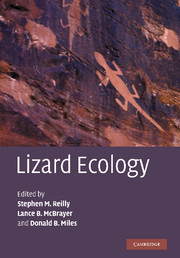Book contents
- Frontmatter
- Contents
- List of contributors
- Preface
- Historical introduction: on widely foraging for Kalahari lizards
- I Organismal patterns of variation with foraging mode
- II Environmental influences on foraging mode
- 12 The foraging biology of the Gekkota: life in the middle
- 13 Foraging mode in the African cordylids and plasticity of foraging behavior in Platysaurus broadleyi
- 14 Interactions between habitat use, behavior, and the trophic niche of lacertid lizards
- 15 Food acquisition modes and habitat use in lizards: questions from an integrative perspective
- 16 The evolution of foraging behavior in the Galápagos marine iguana: natural and sexual selection on body size drives ecological, morphological, and behavioral specialization
- 17 The evolution of the foraging mode paradigm in lizard ecology
- Index
- References
14 - Interactions between habitat use, behavior, and the trophic niche of lacertid lizards
Published online by Cambridge University Press: 04 August 2010
- Frontmatter
- Contents
- List of contributors
- Preface
- Historical introduction: on widely foraging for Kalahari lizards
- I Organismal patterns of variation with foraging mode
- II Environmental influences on foraging mode
- 12 The foraging biology of the Gekkota: life in the middle
- 13 Foraging mode in the African cordylids and plasticity of foraging behavior in Platysaurus broadleyi
- 14 Interactions between habitat use, behavior, and the trophic niche of lacertid lizards
- 15 Food acquisition modes and habitat use in lizards: questions from an integrative perspective
- 16 The evolution of foraging behavior in the Galápagos marine iguana: natural and sexual selection on body size drives ecological, morphological, and behavioral specialization
- 17 The evolution of the foraging mode paradigm in lizard ecology
- Index
- References
Summary
Introduction
The existence of evolutionary trade-offs prevents simultaneous optimization of different functions that require opposing biomechanical or physiological adaptations (Stearns, 1992). Consequently, trade-offs likely play an important role in niche partitioning, in that species specialized in exploiting one type of niche (e.g. microhabitat) are expected to be less proficient at exploiting others. For instance, in Anolis lizards, a trade-off exists between sprint speed and sure-footedness because long limbs are required to move fast, whereas short limbs aid sure-footedness (Losos and Sinervo, 1989; Losos and Irschick, 1996). Accordingly, species that predominantly move on broad surfaces (i.e. trunk–ground ecomorph) specialize for speed and have long limbs, whereas species living on narrow substrates (i.e. twig ecomorph) are specialized in slower but secure movements.
In a similar fashion, species specializing in different dietary niches may have diverged morphologically because the biomechanical demands on the feeding and/or locomotor apparatus are often not reconcilable within one phenotype. Clearly, the ability of a predator to exploit a certain prey type will depend on the functional characteristics of the prey (e.g. prey distribution, hardness, and escape response) and the performance of the feeding and locomotor system of the predator. For instance, in labrid fishes the amount of force potentially generated by the jaws trades off with the speed of jaw movement because of differences in the four-bar linkage system of the jaws and hyoid (long links aid high force outputs, but rapid movements are realized by short links) (Westneat, 1994, 1995).
- Type
- Chapter
- Information
- Lizard Ecology , pp. 427 - 449Publisher: Cambridge University PressPrint publication year: 2007
References
- 35
- Cited by



